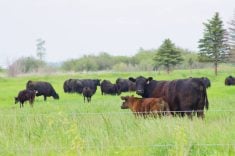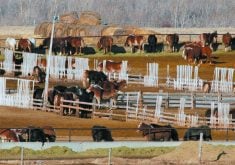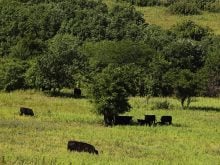Animal vaccines prevent disease, enable good animal welfare and, in the case of food animals, improve overall production.
However, animal vaccines are also used to protect people.
Animals carry infectious agents that can be transmitted to people, and vaccines are one way to manage them.
Vaccinating animals against diseases that are a concern for people serves two functions:
- It reduces transmission of the infectious agent between animal hosts, which lowers the number of infected animals in the population that could pass the infection to people.
- It creates a transmission barrier to infection when domestic animals act as an intermediary between wildlife and people, which is important because people have much more frequent and close contact with their pets and livestock compared to wildlife.
Read Also

Canada told trade crisis solutions in its hands
Canadians and Canadian exporters need to accept that the old rules of trade are over, and open access to the U.S. market may also be over, says the chief financial correspondent for CTV News.
The deadly rabies virus is perhaps the most familiar and widespread example of a veterinary public health vaccine. Many wild animals can carry rabies.
The most important rabies hosts in Canada include bats, foxes, skunks and raccoons. Widespread vaccination of pets, horses and other animals against rabies protects them from the virus but also protects the people in their lives.
Dogs have historically been the most important source of rabies for people in developed countries and currently in the developing world.
This is why rabies vaccines for dogs are so common. It also explains the push to implement widespread dog rabies vaccination in developing countries such as India, where more than 20,000 people still die annually from this disease.
However, creating an immunity barrier by vaccinating pets doesn’t get to the heart of the problem, which is why Western Europe and southwestern Ontario spearheaded the use of oral rabies vaccines for wildlife. The Ontario campaign used an oral rabies vaccine bait to target the disease in raccoons, which are particularly well adapted to living in the urban and suburban areas within and surrounding Toronto.
The E. coli 0157 vaccine for cattle is another example of a veterinary public health vaccine.
This particular strain of bacteria is shed in the feces of asymptomatically infected cattle. During slaughter, the bacteria can contaminate meat and has caused economically significant food recalls and public health scares.
Several vaccines have been developed that significantly reduce the shedding of this bacteria and contamination of meat at slaughter.
However, they are not widely used, probably because they chiefly benefit people rather than animal health, but the cost of administering it would be born by producers and feedlots.
A vaccine for improved food safety also exists for poultry against salmonella.
Vaccines are used to control new infectious diseases that arise from animals. This rapid response capability may prove increasingly important because researchers can develop and license animal vaccines faster than those for people.
The hendra virus in Australia is an example of an animal vaccine to control a new disease.
Hendra virus originates in bats and occasionally makes the leap into horses, causing severe illness. Horses can spread the virus to people, including horse owners and veterinarians who have close contact with sick horses.
Researchers developed a horse vaccination to stop the chain of transmission from bats through horses to people. Vaccination to make the horses immune to the virus reduces the likelihood that they will contract the virus and spread it to people.
This intelligent use of vaccinations is one way scientists are grappling with the issues of emerging infectious diseases. Their use is particularly important where other control methods are unlikely to work.
To use the bat example of Australia, it may be exceptionally difficult to intervene in other ways to prevent transmission, mainly because fruit bats have changed their habitats from more wild areas to suburban regions where people plant and maintain fruit trees. People who invest time and resources to maintain fruit trees are unlikely to cut them down.
Also, bats serve a crucial role in the environment as pollinators, so eliminating bat populations may have unforeseen environmental effects while not necessarily affecting disease transmission.
As well, people don’t seem to acquire these infections directly from bats, which makes the prevention of horse infections a realistic and possibly highly effective method of control.
Future veterinary public health vaccines are likely in development for a wide variety of diseases, including tuberculosis and chronic wasting disease.
Vaccination to control food animal disease as alternatives to antibiotics will be another important application.
Preventing bacterial diseases rather than treating with antibiotics will decrease antibiotic use and limit antibiotic resistance.
Vaccinating animals for infectious agents that matter to people is a rational and increasingly useful method for enhancing public health.















